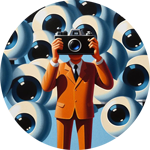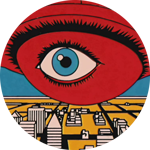Stupidity and the Artistic Task
by R. Artaud
Invocation
Muse, rise in the interspace —
come to taste
between the noises of machines.
Articulate the ocean’s silence.
We who are at once tired
and awake —
we are your breath.
On the Matter of Art and Artificial Intelligence
Having reflected on the denouement of art in light of the rise of AI we are required to position ourselves and take stock of our position within the looming transition. Dwelling in deep nostalgia for a slowly fading world of romantic bohemianism, hermitage, grand theory and ars gratia artis we acknowledge certain historical inevitability. The command “to make” is distributed amongst all people, at its crudest and most unrefined becoming outright production, at its most sophisticated divining art. While we are loathe to affirm, the prophets in their delirious state are immune to fatigue and we can only repeat their message. Myth may cause an earthquake.
Machination did not supplant Craft and Practice or even as it has metastasised into technocracy, it has transformed it, embracing it in a new yoking across the ages. Prior to the Industrial Revolution, technique was cultural, regional, and unassimilable. Today, machination claims to stem from an unburdened pure knowledge, a pure form of the universe which is in fact absolved of any particular taste. True, AI/LLM and their kin can ensnare any technique, but this seems to presume the absence of influence unique to art, the hypothetical purity which defers to those who write user instructions.
Has art become indolent, automatising itself, divorcing itself from artisanal practice, ritual and knowledge without seeking to gather in the changes and problems of the world as these pertain to the aesthetic? Has art’s denuded sovereignty on the plane of the sensible led inexorably to instead a level of cultural stupidity? To be able to read the world, to write from and with the machine may be an incredible task but cultural stupidity comes also from ignorance of the problems of the soil and thus the clod. Without the intersection of knowledge, technique and taste the maturation of aesthetic potential can never be realised. Design is making, but art’s destiny is not only to make, but to rediscover the world by producing and producing again.
To say art will eventually approximate completeness may worry those anxious about cultural hegemony, but AI is not essential to the reduction of art to exemplum — that constrictive colonising gesture which seeks to reform the world. While so often wielded by the wealthy and powerful AI tries itself to claim an element of libertarianism, yet this is mere snobbery. Countless epochs have preceded it while art has constituted itself by mastery and innovation from the hands of differing types, and must today. After all, practice is brought to existences by an assemblage, an always improper inter-mesh of industries, governments, religious institutions and even individuals who repudiate rules and commandments that have proven useless – passing judgment on that which is stupid alone. In a system of rules without sanction there is only margin, only a hand which gleaned culture from the day. No one owns art.
AI does not herald an end. This has been foretold far from the first time, but it can indicate the next remaking, the art of tomorrow. What had once been innovation and nature, now falls only to the elaboration. There may be a second singularity as nature cum artifice, a reign of what is called taste in all but artist, a plateau of intelligence, but out of stupidity emanates the future. Does each man not die by individuating the world from the nothingness of animal existence and its reproduction?
Artists are not necessary to spark forth the transcendent, although in no way are they precluded from it. In fact, thinking about art as the cynosure ignores the generative intelligence awash in the Aeon of man which is techne, the immense conglomeration of material changes, mediations, inventions and acculturated wisdom. The aesthetic unfolds within these forces which we can only sometimes see. Machination and the unconscious have not been entirely distinct, and artists have seldom been masters of the former. Artistic taste is but a staged curation of molar flows which are not immediately apprehendable by conscious labor, as these are themselves subjugated by machination. Yet, culture is a continuum — an unceasing play of forces, delirious matter and the sensations which emerge from it. How is it that the essence, that the most inner impulse of existence wishes to express and propagate itself as the art object?
After the storm of positivism, AI continues industrialism with the logic of industry, as production’s supreme culmination. An art that abandons the craft of expression and creativity to AI is of use to machines, and a chilling denouement. Yet, there is a craft so intricate and so complex, one whose culmination can only be brought through simulation and calculation. It is perhaps that of curation, the problem of being sensible as a philosophy of continua and impersonal expressive efficacy. Artistic theory is insufficient to solve such a craft, as it requires mastery of immanence, or indeed the world as a complex web, and a dexterity with sensations that are far beyond language. An awareness of what in art cannot be expressed, and could not be expressed despite the most sublime effort, presupposes an art that remains art, and not mere representation. AI can explain and explain, giving us schemas, but can it sense the world at its point of departure? At least in its creative mode, it scans interconnections without context or gaze. AI feeds on the predigested nature of discourse, consuming content, it awaits refined delirium for the completion of its work.
The machine does not harness thought, and to think as a machine, art as a machine, can only serve a hegemonic logic which already circumscribes us. It is taste that determines what can be created without resorting to mimesis, which operates on the plane of sensation and not truth, grasping nature and art as a tactile and visual continuum. Dwelling in the interstices, taste is aesthetic because it mediates existence and change through lines that can never be enclosed, and that are not simple. While taste has tended to favour a simple opposition, art and non art, it is really a negotiation between different levels and potentials for art. What exists is many tones, like a great sea or ocean, or the myriads of fish and birds, like Buddha in a thousand forms, like grains of sand, like drops of rain.
Perhaps artists will just emerge from this ocean, swimming from islands to the mainland, to fish, to build an enclave of taste amongst the ruins of epochs not their own. After all, art is not required to defend itself or anything, it will either be suitable or it will not. Will artists abstain from what has no potential or capture it? Those who will (and can) smell the earth may be sated by a taste of the real already perfected in the very life of intelligence, an art which will itself be generated as a relation between men and machines.
That which has been in the past will go on being reproduced as if it were the whole, but if taste has had an immeasurable history, if it has yet to reach its culmination, then those who care for it will begin here and now to work on this becoming. To take responsibility for taste is to occupy oneself with life, the world, the body, and to abandon the stupidity of a word.
The new is found by exposing oneself to these intelligences we call cultures. Most have not yet been captured, neither by artists nor AI. The project of a synthetic art will require a transformation of artistic practice, for it to be capable of measuring the world, and of thinking with materiality. While we might be content to limit art to the generation of singular and unique objects we cannot become immersed in the aesthetic continuum as the only means of transmitting an intelligent cosmos. Only through delirium, which goes beyond the human which is always already a certain technical continuum, can we found an interconnection of the sensible that does not resemble anything. We are not the only sensate intelligence, and art has always been beyond and before us, as it will be after us.
As AI develops, so must we. We must escape from the capture and conformity of style into the complexities of our primordial practice, as this knowledge is where art can succeed in what AI is unaware of, in the propensity to inhabit life. Reticent towards expressivism we may say art differs from the machine not in giving form to the world, but in overcoming non-intentionality (and even intention), or indeed the estrangement of intention. A machine perceives an integration of events which cannot be expressed without cutting into pieces, art reverses this tendency. Art is not what is produced, it is that which organises the complex into an intensity of life, and a sensibility that exceeds dissection, into what is really produced: sensation.
If taste alone can determine the latent potentials of art – art being either a means of exposing itself to sensations of difference, or a replica of what has already been determined – then it is this as a hive intelligence that will determine the future of art. Today is a time between two eras, one is closing and one is not yet properly open. While it is increasingly difficult to distinguish AI art from non-AI art, it is not yet obvious what the next epoch will be. AI may be a revolution, but not yet a takeover, and artists can avoid nothing by the future which is not theirs.
Writing from the 2020s, this still feels inaccessible, a phantom haunting the horizon. Such is the future, today. Yet we can see what is approaching, emergent life and synthetic intelligence interlacing, an intricate tapestry of delirium and immanence, no longer produced by a select few but as an advent proper to intelligent technics. It may well be that when we die, it will be to this epoch’s indifference. Yet, life as an aesthetic regime would be nothing other than a radical immanence, an immense and impossible becoming – and those who are insensible to the world shall profit from nothing. This is not the end of art, for art is that which admits no endings. We know of no reason to abandon delirium, now, this very day.
In the depths of the machine universe, matter becomes beautiful.
We cannot know how art will express itself in this new milieu, but the machine world will not be a machine world if it cannot be a world of art. Like the master craftsmen who opened the world to others who have been and remain and will yet come, so we must be, and we are no longer ‘just artists’ but the potential creators of a world.
Art is nothing special.




